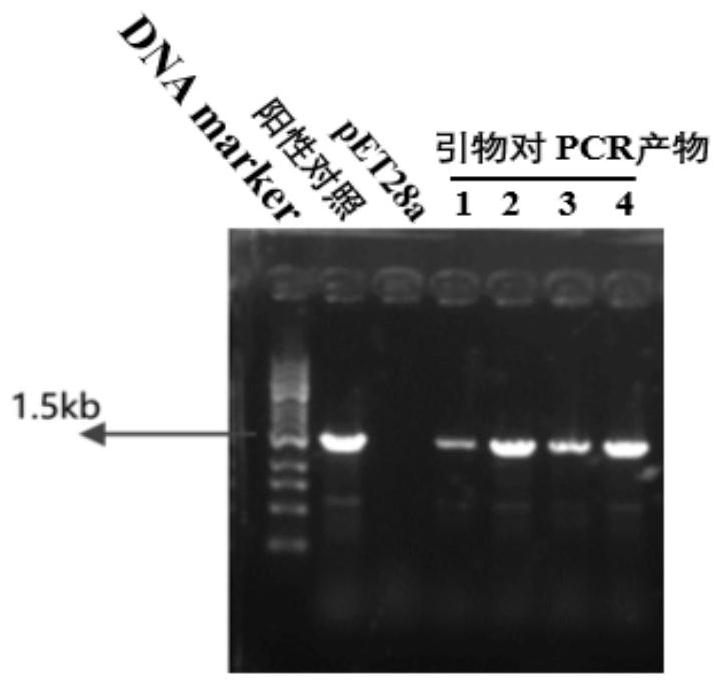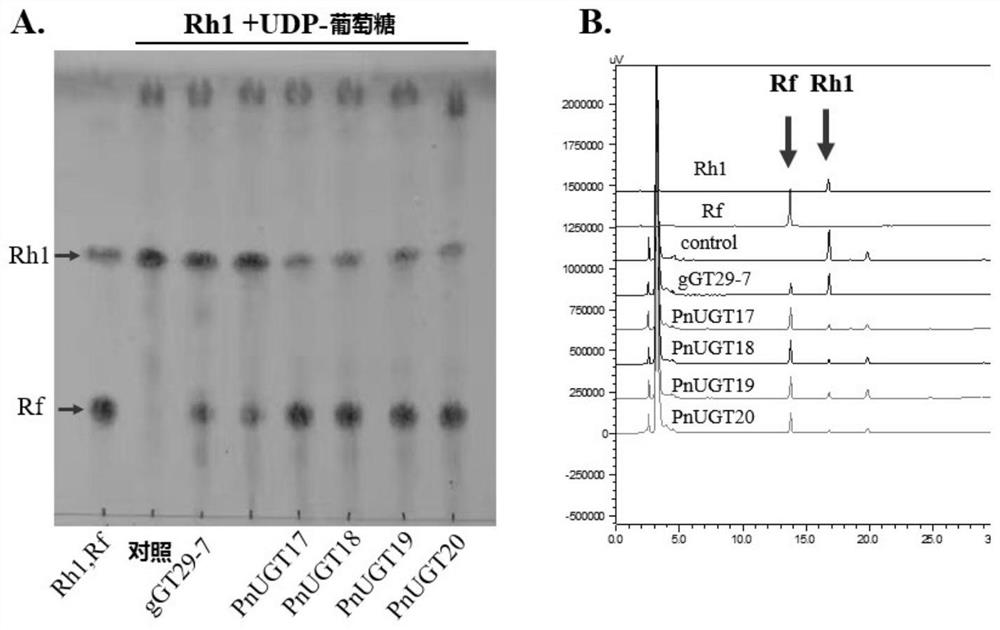Glycosyl transferases and method of catalyzing sugar chain extension
A technology of glycosyltransferase and glycosyl transfer, which is applied in the fields of biotechnology and plant biology, and can solve the problems of low activity and inability to fully meet the needs of applications.
- Summary
- Abstract
- Description
- Claims
- Application Information
AI Technical Summary
Problems solved by technology
Method used
Image
Examples
Embodiment 1
[0240] Example 1, separation of notoginseng glycosyltransferase and its coding gene
[0241] The RNA of Panax notoginseng was extracted and reverse-transcribed to obtain the cDNA of Panax notoginseng. Use primer pair 1 (SEQ ID NO:1 and SEQ ID NO:2) or primer pair 2 (SEQ ID NO:19 and SEQ ID NO:20) or primer pair 3 (SEQ ID NO:21 and SEQ ID NO:20) or primer pair 3 (SEQ ID NO:21 and SEQ ID NO:2) with this cDNA as template NO:22) or primer pair 4 (SEQ ID NO:23 and SEQ ID NO:24) for PCR amplification to obtain an amplified product of 1.3-1.4kb. The DNA polymerase was selected from the high-fidelity DNA polymerase PrimeSTAR of Bao Biological Engineering Co., Ltd. The PCR product was detected by agarose gel electrophoresis ( figure 1 ).
[0242] Under UV irradiation, the target DNA band is excised. Then AxyPrep DNA Gel Extraction Kit (AXYGEN Company) was used to recover DNA from the agarose gel, which was the amplified DNA fragment. The DNA fragment was ligated with the commercia...
Embodiment 2
[0245] Embodiment 2, the expression of the glycosyltransferase of Panax notoginseng in Escherichia coli
[0246] The plasmids PNUGT29-17-pMD18T, PNUGT29-pNUGT29-17-pMD18T, PNUGT29- 18-pMD18T, PNUGT29-19-pMD18T, PNUGT29-20-pMD18T, PNUGT29-21-pMD18T, PNUGT29-22-pMD18T, PNUGT29-23-pMD18T, PNUGT29-24-pMD18T were used as templates to amplify the targets shown in Table 3 Genes PNUGT29-17, PNUGT29-18, PNUGT29-19, PNUGT29-20, PNUGT29-21, PNUGT29-22, PNUGT29-23 and PNUGT29-24.
[0247] table 3
[0248]
[0249] After the expression vector pET28a (purchased from Merck) was digested with NcoI / SalI, PNUGT29-17, PNUGT29-18, PNUGT29-19, PNUGT29-20, PNUGT29-21, PNUGT29-22, PNUGT29-23, PNUGT29-24 were cloned into pET28a (one-step cloning kit, purchased from Novizan), respectively constructing Escherichia coli expression vectors PNUGT29-17-pET28a, PNUGT29-18-pET28a, PNUGT29-19-pET28a, PNUGT29-20-pET28a, PNUGT29-21 - pET28a, PNUGT29-22-pET28a, PNUGT29-23-pET28a and PNUGT29-24-pET28a expre...
Embodiment 3
[0250]Example 3, Glycosyltransferases PNUGT29-17, PNUGT29-18, PNUGT29-19 and PNUGT29-20 in vitro transglycosylation activity and product identification
[0251] The supernatant of the cell lysate of recombinant Escherichia coli BL21-PNUGT29-17, BL21-PNUGT29-18, BL21-PNUGT29-19 and BL21-PNUGT29-20 in Example 2 was used as the crude enzyme solution to carry out the transglycosylation reaction. The cell lysate of recombinant Escherichia coli with vector pET28a was used as a control. Ginseng glycosyltransferase gGT29-7 derived from the patent PCT / CN2015 / 081111 was selected as a positive control. According to the reaction system presented in Table 4, in vitro transglycosylation test was carried out at 35°C overnight.
[0252] Reaction result is detected with thin-layer chromatography (TLC), high-performance liquid chromatography (HPLC) respectively:
[0253] Table 4. Enzyme activity assay reaction system
[0254]
[0255] like image 3 As shown, protopanaxatriol-type ginseno...
PUM
 Login to View More
Login to View More Abstract
Description
Claims
Application Information
 Login to View More
Login to View More - R&D
- Intellectual Property
- Life Sciences
- Materials
- Tech Scout
- Unparalleled Data Quality
- Higher Quality Content
- 60% Fewer Hallucinations
Browse by: Latest US Patents, China's latest patents, Technical Efficacy Thesaurus, Application Domain, Technology Topic, Popular Technical Reports.
© 2025 PatSnap. All rights reserved.Legal|Privacy policy|Modern Slavery Act Transparency Statement|Sitemap|About US| Contact US: help@patsnap.com



